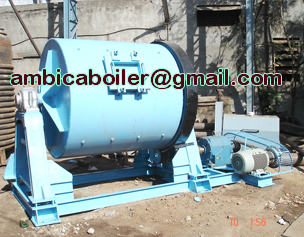Resin Plant, Polyester Resin Plant Manufactuer, Alkyd Resin Plant, Melamine Resin Plant Manufacturer, Phenol Formaldehyde Resin Plant Reaction vessel, Sigma Mixer Machine, Ribbon Blender Mixer Machine,Stainless Steel Reaction Vessel, Paste Kettle, High Speed Disperser, Paint Machinery
Ball Mill Principle
A ball mill works on the principle of impact and attrition: size reduction is done by impact as the balls drop from near the top of the shell.

Ball Mill Construction
ball mill consists of a hollow cylindrical shell rotating about its axis. The axis of the shell may be either horizontal or at a small angle to the horizontal. It is partially filled with balls. The grinding media is the balls, which may be made of steel (chrome steel), stainless steel, ceramic, or rubber. The inner surface of the cylindrical shell is usually lined with an abrasion-resistant material such as manganese steel or rubber. Less wear takes place in rubber lined mills. The length of the mill is approximately equal to its diameter.
Ball Mill Working
In case of continuously operated ball mill, the material to be ground is fed from the left through 60° cone and the product is discharged through a 30° cone to the right. As the shell rotates, the balls are lifted up on the rising side of the shell and then they cascade down (or drop down on to the feed), from near the top of the shell. In doing so, the solid particles in between the balls and ground are reduced in size by impact.
Design Specification
A ball mill, a type of grinder, is a cylindrical device used in grinding (or mixing) materials like ores, chemicals, ceramic raw materials and paints. Ball mills rotate around a horizontal axis, partially filled with the material to be ground plus the grinding medium. Different materials are used as media, including ceramic balls, flint pebbles and stainless steel balls. An internal cascading effect reduces the material to a fine powder.
Industrial ball mills can operate continuously, fed at one end and discharged at the other end. Large to medium-sized ball mills are mechanically rotated on their axis, but small ones normally consist of a cylindrical capped container that sits on two drive shafts (pulleys and belts are used to transmit rotary motion). A rock tumbler functions on the same principle. Ball mills are also used in pyrotechnics and the manufacture of black powder, but cannot be used in the preparation of some pyrotechnic mixtures such as flash powder because of their sensitivity to impact.
We are a prominent organization engaged in manufacturing and supplying Ball Grinding Mill . Ball Grinding Mill are most suitable to grind even the hardest rock with uniform fineness up to 300 mesh with minimum ware & tear. For jerk free rotation the entire shell is balanced charging / discharging door is designed. Prince is making rotary screens also in different diameters, length and segments driven through central shaft with crown & pinion gear to prevent flying dust covers may be provided as an option. However, for wet grinding and mixing light duty ball mill are also available as an option, inner may be provided either of CI, MS, SS, Mn Steel, Ceramic or any other suitable material.
- Size: The smaller the media particles, the smaller the particle size of the final product. At the same time, the grinding media particles should be substantially larger than the largest pieces of material to be ground.
- Density: The media should be denser than the material being ground. It becomes a problem if the grinding media floats on top of the material to be ground.
- Hardness: The grinding media needs to be durable enough to grind the material, but where possible should not be so tough that it also wears down the tumbler at a fast pace.
- Composition: Various grinding applications have special requirements. Some of these requirements are based on the fact that some of the grinding media will be in the finished product. Others are based in how the media will react with the material being ground.
- Where the color of the finished product is important, the color and material of the grinding media must be considered.
- Where low contamination is important, the grinding media may be selected for ease of separation from the finished product (i.e.: steel dust produced from stainless steel media can be magnetically separated from non-ferrous products). An alternative to separation is to use media of the same material as the product being ground.
- Flammable products have a tendency to become explosive in powder form. Steel media may spark, becoming an ignition source for these products. Either wet-grinding, or non-sparking media such as ceramic or lead must be selected.
- Some media, such as iron, may react with corrosive materials. For this reason, stainless steel, ceramic, and flint grinding media may each be used when corrosive substances are present during grinding.
- The grinding chamber can also be filled with an inert shield gas that does not react with the material being ground, to prevent oxidation or explosive reactions that could occur with ambient air inside the mill.
 Address:
24/A, Laxmi Industrial Estate, Amraiwadi,
Ahmedabad - 380 026, Gujarat, INDIA
Address:
24/A, Laxmi Industrial Estate, Amraiwadi,
Ahmedabad - 380 026, Gujarat, INDIA Phone:
Phone: